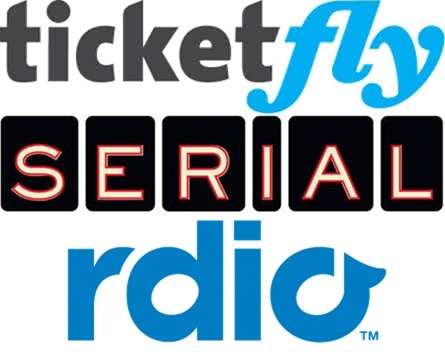Pandora has been in the news these days. In fact, if you look back over the past several weeks, Pandora has been busily making a series of moves, acquisitions, and announcements. So what’s the plan, Stan?
The shorthand is they acquired Ticketfly, they’re carrying the world-famous Serial podcast, and now they’ve acquired the financially challenged Rdio.
These may seem like disparate, unconnected moves. After all, what does a ticket buying service, a podcast, and an on-demand streaming have in common?
The thread here is that Pandora has acknowledged they cannot simply be a music service here in the States. In order to survive, thrive, and eventually turn a profit, they need to provide a more diverse, robust, content-rich experience to a voracious consumer who’s always looking for more.
The combination of a ticket buying service linked to the music, a wildly successful podcast, and the ability to provide more of a Spotify-like streaming experience outside the U.S. broadens out Pandora’s appeal, and make it more competitive in the on-demand space.
The other Pandora announcement that should earn our attention was about a fraction – 3½ , to be exact.
That’s the number of minutes Pandora’s brain trust has concluded they can devote to commercials each and every hour. Using their metrics, they’re determined that’s the ceiling for ads on their streaming service. As their CFO, Mike Herring, explained at a recent Wells Fargo get-together, their in-house tolerance metrics show that 3½ is the upper limit “at the most.” Compare that to the 10+ minutes an hour of commercials heard on most FM stations, and it is easy to understand how Pandora has grown during the past decade.
But given the costs of streaming royalties, Pandora must turn to other revenue sources and models. If not, radio pros are only too aware of the financial pressures that necessitate increasing spot loads. And given Pandora’s streaming competition, keeping the experience positive is an imperative.
Pandora also realizes that a clean, pristine music machine won’t get it done. Radio research has shown the same thing for decades; while a jukebox-like, jock-less presentation may be adequate at launch, the key to long-term, sustainable success is a full-featured approach. Apple and Spotify are headed down that same road.
Pandora is proving once again that it’s read the Radio Rulebook, as it writes its own chapters.
- What To Do If Your Radio Station Goes Through A Midlife Crisis - April 25, 2025
- A 2020 Lesson?It Could All Be Gone In A Flash - April 24, 2025
- How AI Can Give Radio Personalities More…PERSONALITY - April 23, 2025







More of a stock play than an operationally profitable business, Pandora sees the same light that most other streaming companies (and satellite radio) saw years ago. Non commercial, no-host music services are not worth the price of admission to most people. Even with a maximum of 3 1/2 minutes of commercials per hour, Pandora’s self-described limit. To be sure, it’s a solid product. But being popular and making a profit are different subjects. In the same way that Groupon and satellite radio changed their direction after years of big headlines—and huge cash burn—Pandora is starting to morph.
That they are, Jack, and it’s an interesting process to watch. They may not make all the right moves, but its fascinating to see how they’re building out and expanding their holdings, leveraging their big “cume” against everything from podcasts to concert tickets. Thanks for the comment and for reading our blog.
Yes, and Pandora CEO Tim Peterson said: “Pandora plans to open a subscription-based, on-demand version of its music-streaming service because advertising revenue may not be enough to offset ballooning content acquisition costs.” In Q3 of 2015 “Pandora’s ad revenue only grew 31%, year to year, while its content acquisition costs soared 90%, and it failed to turn a profit after deducting operating expenses.”
Hard to be successful when your expense goes up twice as fast as your revenue.
And there’s the adding units conundrum. It will be hard to maintain the 3.5 minute rule with hungry salespeople congregating outside your door.
Yeah, and when you find yourself saying, “Pandora’s ad revenue >>only<< grew 31%, year to year" (emphasis mine), maybe something's wrong with your business model.
Reminds me of the days when radio stations were first being bought for stupidly high numbers, and world-class sales teams couldn't keep up with the fanciful revenue numbers they were told to hit!!
True that. Thanks, Chris.
This may be a distorted metric. Content costs are rising at this ridiculous (90% YOY) rate because the metric for determining them is one sided, unfair and (even if you disagree with the first two) unprecedented. The increase is all due to royalties and With a reasonable royalty structure, Pandora could probably make a respectable profit.
Spotify has the same royalty problem as Pandora, so its questionable whether Pandora’s planned Spotify type service will help their bottom line any. That said, the rekkid biz has a lot more clout and lobbying dollars than Pandora, so this is unlikely to change until Pandora has no more stock to sell to fund operations and shuts down.
It’s an onerous business model to be sure, Bob. Broadcasters clearly have better scale when you figure that once the land is bought, the license is in hand, the tower is erected, and the transmitter is turned on, listeners acquisition (not to mention time spent listening) really doesn’t generate more costs. There are many things about radio Pandora envies, but this is most surely one of the bigger ones. Thanks for commenting.